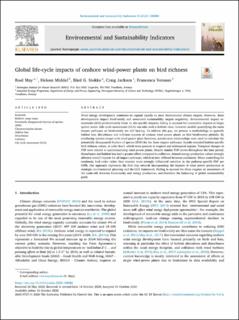| dc.contributor.author | May, Roelof Frans | |
| dc.contributor.author | Middel, Heleen | |
| dc.contributor.author | Stokke, Bård Gunnar | |
| dc.contributor.author | Jackson, Craig Ryan | |
| dc.contributor.author | Verones, Francesca | |
| dc.date.accessioned | 2021-02-25T13:45:11Z | |
| dc.date.available | 2021-02-25T13:45:11Z | |
| dc.date.created | 2020-11-02T12:28:07Z | |
| dc.date.issued | 2020 | |
| dc.identifier.citation | Environmental and Sustainability Indicators. 2020, 8 . | en_US |
| dc.identifier.issn | 2665-9727 | |
| dc.identifier.uri | https://hdl.handle.net/11250/2730470 | |
| dc.description.abstract | Wind energy development continues to expand rapidly to meet international climate targets. However, these developments impact biodiversity and associated sustainability targets negatively. Environmental impact assessments (EIA) predominately focus on site-specific impacts; failing to account for cumulative impacts at larger spatial scales. Life cycle assessments (LCA) can take such a holistic view, however models quantifying the main impact pathways on biodiversity are still lacking. To address this gap, we present a methodology to quantify habitat loss, disturbance and collision impacts of onshore wind power plants on bird biodiversity globally. By overlaying species ranges with wind-power plant locations, species-area relationships were used to calculate the potentially disappeared fraction of species (PDF) for the three impact pathways. Results revealed habitat-specific bird richness values, at order level, which were greatest in tropical and subtropical regions. Temporal changes in PDF were related to operationalizing wind-power plants. Despite similar PDF curves throughout the time period, disturbance and habitat loss had a greater effect compared to collisions. Annual energy production values strongly affected overall impacts for all impact pathways, which in turn differed between continents. When controlling for continent, bird order rather than country more strongly influenced variation in the pathway-specific PDF per GWh. Our approach represents the first step towards incorporating the impacts of wind power production in strategic environmental planning and the LCA framework. Failing to account for these negates an assessment of the trade-offs between biodiversity and energy production, and therefore the balancing of global sustainability goals. | en_US |
| dc.language.iso | eng | en_US |
| dc.publisher | Elsevier | en_US |
| dc.rights | Navngivelse 4.0 Internasjonal | * |
| dc.rights.uri | http://creativecommons.org/licenses/by/4.0/deed.no | * |
| dc.title | Global life-cycle impacts of onshore wind-power plants on bird richness | en_US |
| dc.type | Peer reviewed | en_US |
| dc.type | Journal article | en_US |
| dc.description.version | publishedVersion | en_US |
| dc.source.volume | 8 | en_US |
| dc.source.journal | Environmental and Sustainability Indicators | en_US |
| dc.identifier.doi | 10.1016/j.indic.2020.100080 | |
| dc.identifier.cristin | 1844084 | |
| dc.description.localcode | © 2020 The Author(s). Published by Elsevier Inc. This is an open access article under the CC BY license (http://creativecommons.org/licenses/by/4.0/). | en_US |
| cristin.ispublished | true | |
| cristin.fulltext | original | |
| cristin.qualitycode | 1 | |

